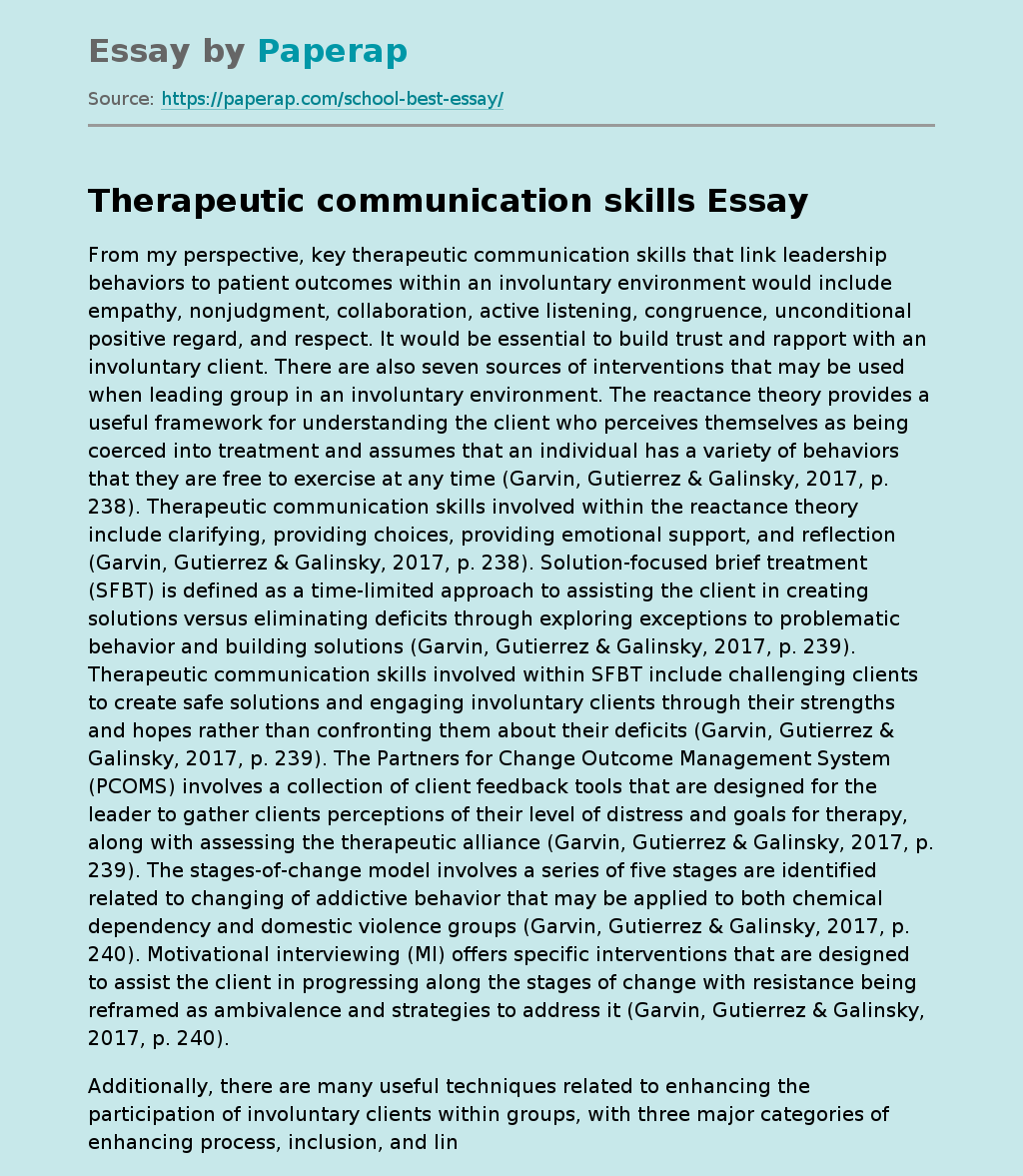The Therapeutic Communication Skills
From my perspective, key therapeutic communication skills that link leadership behaviors to patient outcomes within an involuntary environment would include empathy, nonjudgment, collaboration, active listening, congruence, unconditional positive regard, and respect. It would be essential to build trust and rapport with an involuntary client. There are also seven sources of interventions that may be used when leading group in an involuntary environment. The reactance theory provides a useful framework for understanding the client who perceives themselves as being coerced into treatment and assumes that an individual has a variety of behaviors that they are free to exercise at any time (Garvin, Gutierrez & Galinsky, 2017, p.
238). Therapeutic communication skills involved within the reactance theory include clarifying, providing choices, providing emotional support, and reflection (Garvin, Gutierrez & Galinsky, 2017, p. 238). Solution-focused brief treatment (SFBT) is defined as a time-limited approach to assisting the client in creating solutions versus eliminating deficits through exploring exceptions to problematic behavior and building solutions (Garvin, Gutierrez & Galinsky, 2017, p. 239).
Therapeutic communication skills involved within SFBT include challenging clients to create safe solutions and engaging involuntary clients through their strengths and hopes rather than confronting them about their deficits (Garvin, Gutierrez & Galinsky, 2017, p. 239). The Partners for Change Outcome Management System (PCOMS) involves a collection of client feedback tools that are designed for the leader to gather clients perceptions of their level of distress and goals for therapy, along with assessing the therapeutic alliance (Garvin, Gutierrez & Galinsky, 2017, p. 239). The stages-of-change model involves a series of five stages are identified related to changing of addictive behavior that may be applied to both chemical dependency and domestic violence groups (Garvin, Gutierrez & Galinsky, 2017, p. 240). Motivational interviewing (MI) offers specific interventions that are designed to assist the client in progressing along the stages of change with resistance being reframed as ambivalence and strategies to address it (Garvin, Gutierrez & Galinsky, 2017, p. 240).
Additionally, there are many useful techniques related to enhancing the participation of involuntary clients within groups, with three major categories of enhancing process, inclusion, and linking (Garvin, Gutierrez & Galinsky, 2017, p. 243). Process interventions identify the emotional message that is behind the client’s statement and reflects the client’s worldview, linking interventions connect the client’s individual problems with others in the group and allows the group leader to make generalized statements about the group itself, and inclusion interventions encouraged members that are uninvolved to join the group discussion along with including didactic and projective exercises which essentially allow members to voice their opinion without being singled out (Garvin, Gutierrez & Galinsky, 2017, p. 243). The sophistry method involves encouraging group members who have committed a crime to debate the pros and cons of faulty beliefs without acknowledging their own views, which can help members assess whether those beliefs may play a part in legal difficulties (Garvin, Gutierrez & Galinsky, 2017, pp. 243-244).
An intervention that does not insist that the client labels themselves as deviant, but rather focuses on action, such as with motivational interviewing (MI), is likely to help them achieve their goals and less likely to provoke a confrontation-denial cycle (Garvin, Gutierrez & Galinsky, 2017, p. 244). There are eight guidelines suggested for leaders working with involuntary groups; 1) make an organizational decision as to whether or not the group must be involuntary, 2) conduct pre-group orientation, 3) emphasize methods that assist in the joining and inclusion in early sessions, 4) as group members progress into the contemplation stage, place emphasis on deciding to make a change, 5) assist members in the action stage to plan specific actions to address problems, 6) place emphasis on reporting success and exploring exceptions, 7) place emphasis on taking responsibility for choices rather than confrontation, and 8) utilize clear criteria in terms of group completion (Garvin, Gutierrez & Galinsky, 2017, pp. 244-249).
The Therapeutic Communication Skills. (2019, Nov 29). Retrieved from https://paperap.com/school-best-essay/

